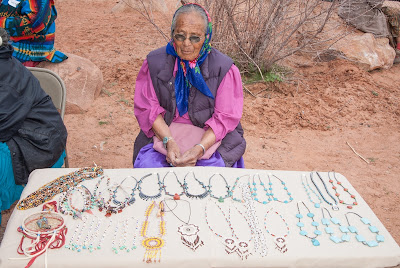by John Aldrich
This article is part of a series describing the various food runs that the Adopt-A-Native-Elder Program conducts to eleven different locations around the Navajo Reservation. These locations are served in groups of two or three sites per trip. The articles will hopefully be of general interest but also serve as an orientation for prospective food run volunteers and for those who have signed up for a particular food run.
The Oljato food run is one of a pair, the other being Navajo Mountain. This food run set is the first of the spring and fall seasons and takes place about a month earlier than the remaining food runs. In the spring it occurs in late April and in the fall, late August. These are the most recent of the locations to be added to the areas we serve.
The first Oljato food run took place in the spring of 2003. It was initiated as a result of a generous grant from American Express who wanted to support an area in the Utah portion of the reservation. The following map* shows the Navajo Reservation with particular reference to the location of the food run at Oljato and the lodging base for this run which is Mexican Hat. You can click on the map to see a larger view.
For this food run we meet in the small town of Mexican Hat which is on the north side of the San Juan River just across from the northern boundary of the reservation. The San Juan Inn, with its scenic location on the bank of the river, serves as our lodging.
We meet in the late afternoon and start with an orientation followed by the ceremony that commences each of our food run sets. The motel has a restaurant where we eat as a group following the ceremony.
After breakfast the following morning we meet again for further orientation at 8:00 a.m. and then embark on the drive to Oljato which is roughly a half hour away. This is a highly scenic trip through the Monument Valley area.
And sometimes the convoy must pause for livestock along the roadside.
The Oljato food run is held at the Senior Center which was completed shortly after we began our visits here. It's a nice modern facility with a kitchen where the meal for the food run can be prepared. When we first arrive we pause for a group photo before proceeding with the various tasks necessary to make the food run happen.
The most demanding job physically is unloading all of the food boxes, gift boxes, home care products, and produce and then arranging them in our traditional Rainbow Circle. This job, of course, falls to the men in the volunteer group. The final result is an impressive display and one that the Elders enjoy seeing when they arrive.
As the preparatory work progresses both inside and outside, the Elders continue to arrive. Several volunteers are stationed at the door to greet them and provide assistance as needed.
Many of the volunteers on a particular food run have come to see their adopted Elder. These are always special moments, particularly when a volunteer meets their Elder for the first time.
Once the preparations are finished and the formal part of the food run begins, all the volunteers gather as Linda and Wendy conduct the program.
Since most of the Elders do not speak English, everything must be translated. In Oljato, this is done by Bessie Holiday, our local coordinator who is also the director of the Senior Center.
A variety of things happen during the program, some are administrative while some are meant to delight the Elders. But the highlight for everyone is undoubtedly the giveaways. The Program brings many things to present to the Elders and individual volunteers do the same.
In return, many of the Elders present gifts to the program such as small rugs or craft items.
After the giveaways are complete, a prayer is offered and everyone shares a meal. Initially, all the Elders are served by the volunteers who then have a chance to eat before all the other family members take part.
Then it's time to load the Elders' vehicles.
As the loading takes place, many Elders like to come by and identify their own boxes. When they finally get back home they will spend many hours going through the boxes of food, gifts, and produce.
Another activity taking place at the conclusion of the food run is the opportunity for volunteers to purchase rugs and crafts from the Elders. Those who are "shoppers" enjoy this part of the day.
The food run to Oljato usually ends by around 2:00 in the afternoon. At that point volunteers are free to spend the rest of the day as they wish. Many take the opportunity to visit the Monument Valley Tribal Park which is only a few miles away. Another popular spot to visit is the historic Gouldings Trading Post which has an interesting museum devoted to the history of movie-making in the area.
The destination for the evening is Kayenta, roughly 30 miles further down the highway.
*This map is adapted from the wonderful Indian Country Map published by the Automobile Club of Southern California. Overlays have been created to show the borders of the Navajo Reservation as well as the food run sites (red) and lodging locations (turquoise) utilized by the food runs. Some of the road information is out of date (the roads to Navajo Mountain and the Big Mountain Food Run sites are now paved. Also, the reservation extends considerably further east into New Mexico than is shown on this map.
Saturday, July 27, 2013
Subscribe to:
Post Comments (Atom)
















No comments:
Post a Comment